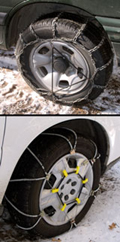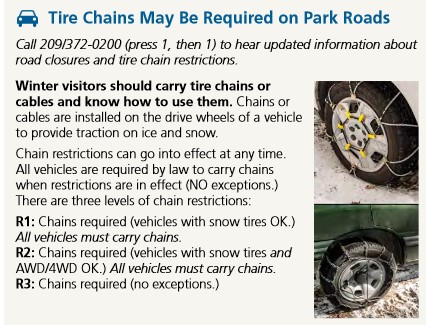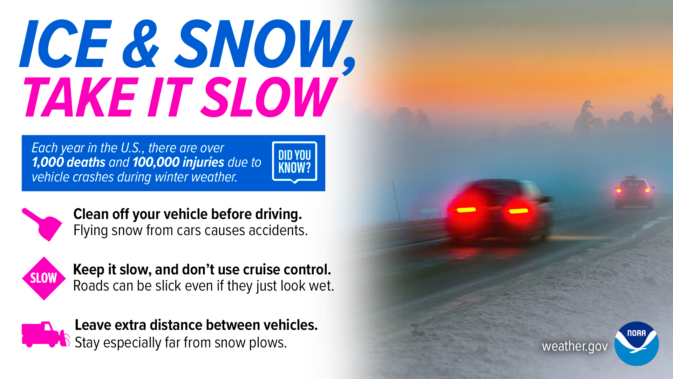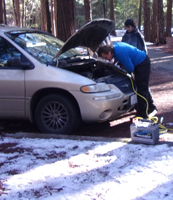This is info for the annual Snow Camp trip of the De Anza College Outdoor Club about buying snow chains with the intention of possibly returning without use or renting snow chains.
The last big town on our usual winter route into Yosemite is Mariposa. Every year they have had lots of chains rentals at the various gas stations on the main drag, but no guarantee they will have your size when you need them.
(If you don’t have chains when you need to put them on and can find a towtruck to bring you a set, AAA (CSAA) will not cover the few hundred dollars cost.)
We do not currently have the time to update all the prices and returns policies for this year’s snow camp trip, but this will give you a head start of you want to rent/buy.
Before a previous trip I did a quick survey of snow chains purchase prices / returns policies and asked about the availability of local rentals. As in the previous year’s surveys I was told that there is too much liability involved in rentals, so no one in our area is doing it anymore, even a ski rental place that used to rent chains. But that still leaves lots of possibilities for our trip, including renting them in Mariposa (with luck).
First
you need to find the owner’s manual and/or look at the tires on your vehicle and write down the numbers on the side. It might say something like P225-75-R15.
You only need to buy/rent chains for two wheels, not all four. They are sold in pairs. You need to figure out which wheels on your vehicle to put the chains on. On most four wheel drive vehicles they should go on the rear wheels. On front wheel drive vehicles they should go on the front, and on rear wheel drive vehicles, they should go on the (you guessed it) rear wheels. If you don’t have an owner’s manual anymore a dealer of your make/model can tell you which tires to put the chains on, but call two dealers to be sure you got the right information. (Chains are more durable than cables but make sure your car doesn’t require cables.)
You can’t put snow chains on some vehicles! If you have aftermarket wheels and big fat tires you might not be able to fit chains on them, as there will not be enough space in the wheel well. Some models don’t have enough clearance between the tire and the suspension, even without bigger wheels/tires. Some manufacturers don’t recommend chains or any other traction device.
below: NPS photo of chains and cables:

From the Yosemite lodging website:
“California State Law, enacted in 1991, requires that all vehicles must carry tire chains/cables at all times when entering a chain control area, such as Yosemite National Park. This requirement is in effect from November 1st to April 1st, though the requirement can be extended based on weather. Failure to comply with this law leaves you vulnerable to fines and charges for any damage done should you have an accident. Additionally, your car may be towed if a law enforcement officer stops you and you do not have chains in your possession. Weather conditions can change quickly in the mountains causing chains to become necessary immediately when traveling at higher elevations.”
Since the Yosemite Rangers can refuse entrance to the park in winter months to people not carrying chains, (even if chains are not currently required on your wheels and even if you have four-wheel drive with snow tires or all weather tires), you should not promise people you are going to drive until you find out if your vehicle can use chains. AND not having chains (NPS quote) “could subject you to an expensive citation.” (Up to $5,000 for failure to put chains on when required.)

The speed limit in all posted chain control areas in Yosemite is 25 MPH and going much faster than that will wear out your chains faster anyway.

If you want to buy chains,
shop around if you are on a budget and be sure to get the store to tell you their returns policy.
Most local auto parts stores do not allow any returns at all or say they might if it was obvious you got the wrong size. This is because they know that people will buy chains and keep them sealed in the box, hoping they won’t need to put them on, then return them if they don’t use them.
Here are some examples of what you might find if you call around:
One year Mel Cotton’s (ooops, that went out of business), allowed returns with receipt and an unopened box. They allowed returns within 30 days and charged a $10 restocking fee IF YOU DID NOT — USE THEM. IF YOU CAN FIND another place that does that AND if we have good weather on the trip and you don’t need to use the chains (AND you remember to keep the receipt and not open the box), then you could return them and get your money back.
The drawback to this is that you can’t try putting on the chains in advance to get used to doing it and be certain they are the right size. Chains are of uniform size, tires vary in size by manufacturer.
W______ Auto had a policy that allowed you to try them on. You could return them within 24 hours, obviously unused, and get a full refund. After 24 hours there was a $20 restocking fee for unused chains. But a club officer told me that more recently, if you return after 24 hours you lose 50% of the value. That is a pretty hefty restocking fee.
Our local NAPA and Kragen’s did not allow returns. Both local Pep Boys I tried calling did not answer their phone after 20 rings, so I don’t know their current policy, but a few years ago they did not allow returns.
One store didn’t have the size I was asking about in stock and said they won’t special order them. The guy at this place put me on hold four times because he didn’t know the answers to my questions and was confused about what P meant. (It means passenger.)
Another place sold only cables and the guy tried to tell me my vehicle has ABS (anti-lock braking system) and therefore cables are preferred. That Jeep did not have ABS and no one I’ve talked to about it says that cables would be preferred.
I have a straight “A” grade average in automotive technology classes here at De Anza and I get especially tired of clerks who don’t know what they are doing and should not be answering the phone, or who try to treat female customers as if we are incapable of understanding simple principles. If you get someone who treats you as if you are incompetent, let the manager know and go to another store.
____________________________________________
ALL these policies could change by the time you go to get/rent your snow chains.
Get the policy in writing from the store.
Don’t put off this purchase until the last minute, as some places that do carry chains run out by mid-winter.
___________________________________
If you rent a vehicle you should learn how to turn off car alarms/disable beeps at the rental business, BEFORE you leave for the trip and be sure the rental company will let you use chains. (A rental company explained chains policies this way “Most rental car companies discourage or forbid the use of snow chains on their vehicles. The reason is chains can cause damage to the vehicle’s wheel wells, tires, or to the road if not installed properly. Many rental contracts explicitly prohibit installing tire chains or cables. If you were to ignore that and damage the car, you’d likely be liable for the repairs, not to mention voiding insurance coverage.”)
___________________________________
Read the chain instructions, do they tell you to stop and retighten after 1/4 to 1/2 mile?
ALWAYS CARRY TIRE CHAINS OR CABLES!
Make sure they are the proper size for your tires and are in working condition.
This is best done at home, on a dry day, in your driveway, before it snows.
It can be wise to practice putting them on before the trip if it has been awhile since you last used them, or if it was always some other person who uses the vehicle you will be driving who put the chains/cables on in the past. I suggest you practice while wearing the pair of warm gloves you will pack with the chains. And a pad to kneel on is also suggested (or do you already have individual knee pads for gardening / construction?).
Chains must be installed on the drive wheels (driving axle).
Make sure you know if your vehicle is front or rear wheel drive.
If you don’t know, ask your mechanic or check your vehicle owner’s manual.
If you have four-wheel-drive you owner’s manual will tell you which two wheels (rear?) to put the two sets of cables/chains on.
___________________________________
Besides the chains, do you also need new wiper blades, deicing fluid for the windshield washer tank, a windshield scraper or deicer?
Pack something to kneel on when you are putting the chains on.
Is it time for new antifreeze or a brake job?
Do the defroster and heater actually function?
Do you know how to use your jack and is it still in the car?
Pack a pair of safety googles with your jumper cables and take a look at
Road trip vehicle prep and recommended service,
which includes important things people can do without paying a mechanic.
Do you need a better battery? In cold weather, batteries are 50 per cent less efficient. If the owner of the Buick below had cleaned the battery terminals before the trip the half hour spent trying to get his car to start on the 2016 trip could have been spent on something more fun. Read Prepare for winter driving
Keep at least a half-full gas tank (to prevent gas line freeze-up). Why? Any space above the gas in the tank has moist air in it. In the cold, especially overnight, that can condense into water. The water will sink to the bottom of the tank and if enough builds up it can end up going to your fuel line and cause hard starting or even block the fuel line completely.
You’ll also want to keep a closer to full tank should you need to change routes, idle, drive slowly or turn back. You can’t buy gas in Yosemite Valley or anywhere near where we will be camping.
One year one of the most popular people on the annual Yosemite snow camp was a woman who brought what must have been a 20-pound bag of cat litter to get cars’ tires unstuck. Yes, the men tried to muscle the car unstuck first. Yes, she said “I told you so.” Buy simple, non-clumping, unscented cat litter or bring sand. In an emergency you could put your floor mats under the drive wheels.
Hey, lots of people lock their keys in the running vehicle when they stop to put on chains!
A spare set of keys in your or someone else’s pocket could be a wise investment.
A can (maybe a few cans) of spray de-icer for your car windshield, windshield washer nozzles and door locks. Invest in enough de-icer. The Centers for Disease Control website warns:
“Never pour water on your windshield to remove ice or snow; shattering may occur.”
– Solvent in your windshield washer reservoir. On a budget? The Yosemite Daily report said: “Top off your wiper fluid reservoir with freeze-proof fluid, a few tablespoons of rubbing alcohol added to standard fluid works as well.”
____________________________________________
 Prepare for winter driving has a link to bad weather driving tips, tips for using tire chains, tricks for dealing with frozen car locks, how to prepare your vehicle for winter driving, a winter survival kit for your car and what to do if you get stranded.
Prepare for winter driving has a link to bad weather driving tips, tips for using tire chains, tricks for dealing with frozen car locks, how to prepare your vehicle for winter driving, a winter survival kit for your car and what to do if you get stranded.
It includes this advice:
My windows are fogging up faster than my navigator can wipe it off!
Yes, it’s cold out and you filled your car with people to share the trip expenses. They all are exhaling foggy breath, especially when you all sing along to that CD. Have them take turns holding their breath. Okay, maybe that’s not practical. Have them pay up for the gas expense in advance and let them off at the next bus stop. Unthinkable? The swimmers in the Outdoor Club know they can lick the inside of their swim goggles to prevent fogging, but a windshield…?
Not really practical either, well then…
The fog on the windows could be caused by trying to keep the car interior warm. When air is warm breath condenses, so stop and have your passengers put on those longjohns, jackets and maybe even hats, then keep the car cool. Even a few degrees will affect the maximum amount of water in the air quite significantly. With less water in the air the windows will frost up less.
Make sure your air conditioner or heater is in the fresh air position rather than recirc. The recirculate setting reuses the humid air already in the car. The air in the car is quite humid due to those mammals you are giving a ride to, and the outside air is less humid (even if it’s raining/snowing), so pull it in and push it against the inside of the window. And even though you are trying to keep the air in the main compartment coolish, the windows themselves need to be warmer than the cold air/rain/snow hitting them, so set the temperature to warm. Pulling in outside air has the drawback of sucking in truck or diesel exhaust, so pull back from that big rig or go around it. Set the fan to its highest setting if you are going in slow traffic.
Now you can go back to your sing-along or heavy gossip session.
Next time you all get into the car, have each person take a seat, then kick their feet together outside of the car to knock excess snow off before they swing their legs in. Less snow melting in the vehicle also means less moisture in the car and less fog on the windows.
It uses less gas to drive with the air conditioning on than to drive with windows open.
Some people recommend wiping your windshield interior with shaving cream to de-fog it, but we do not because it can smell minty to the bears and they break into vehicles they can smell “food” inside of.
_______________________
You might also want to read How to not collide with a deer, Safe driving in rain and fog or wildlife jams
Road trip advice and etiquette has ideas for limiting boredom, getting along on a road trip and some packing and safety tips.
——————————————————————-
The author of this webpage, (written as a reading assignment for my students), does not give any warranty, expressed or implied, nor assume any legal liability or responsibility for the accuracy, completeness, or usefulness of any information, product, or process included in this website or at websites linked to or from it. Users of information from this website assume all liability arising from such use.
